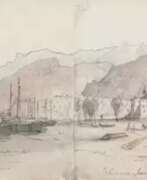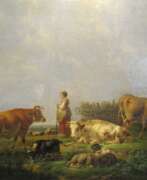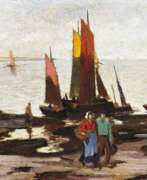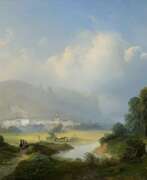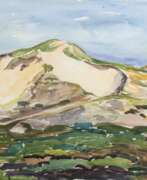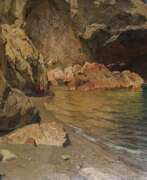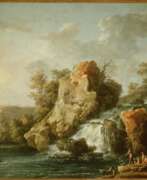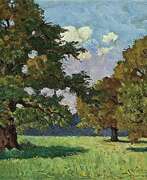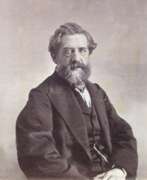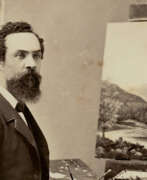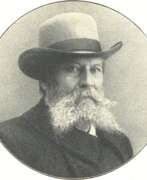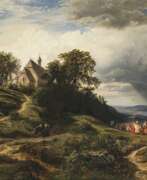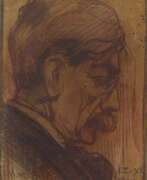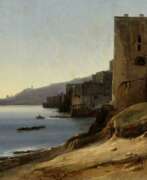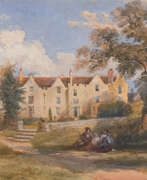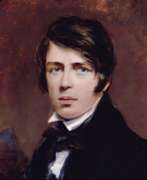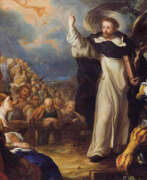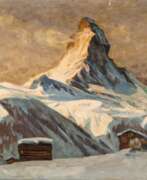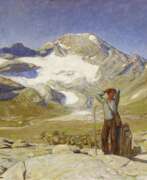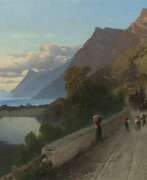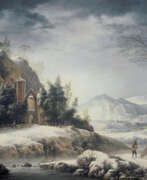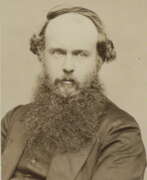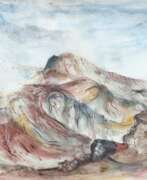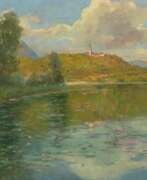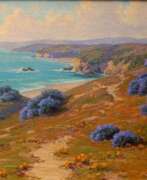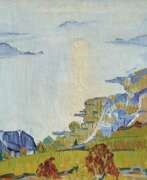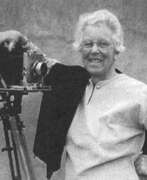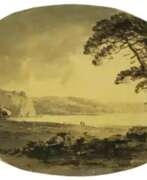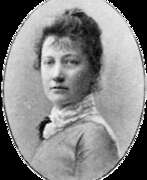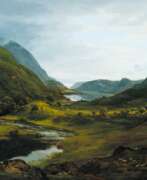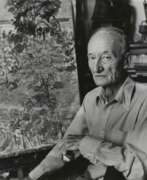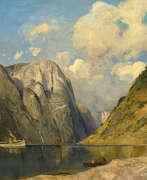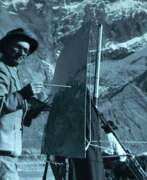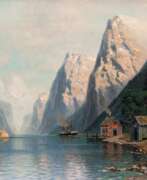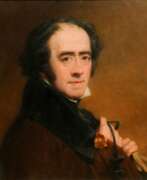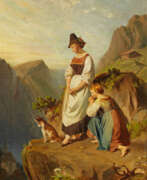Landscape painters Mountain landscape
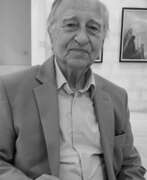

Saad Al-Tai is a contemporary Iraqi artist. He participated in several exhibitions in Baghdad and abroad. Al-Tai was a member of the Iraqi Impressionists Group. Despite the name of the group, Al-Tai was not categorically an impressionist, rather his style lent more towards cubist realism. For him, the colour of the painting was determined by its subject matter. Al-Tai is an award winning artist who, amongst other things, received Italian knighthood in 2005 in recognition for his efforts in fostering Iraqi-Italian cultural dialogue including founding and heading the Italian Language Department in 2002 at the College of Languages, Baghdad University.
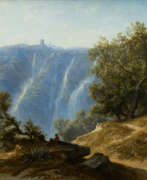

Auguste Anastasi is a French landscape painter of the Barbizon School.
Auguste Anastasi was a student of Paul Delaroche and Jean-Baptiste Corot. He painted landscapes around Paris, Normandy, Holland and Italy, in Rome and especially in Naples, but also in the Tyrol, of which he also made lithographs.
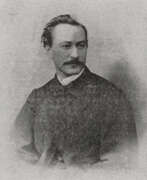

Albert Arnz was a German landscape painter of the Düsseldorf school. He studied painting from 1854 to 1860 at the Dusseldorf Academy of Art, where his two teachers were Andreas and Oswald Achenbach. Arntz painted atmospheric landscapes in Germany, Italy and Switzerland.
Albert Arntz was a member of the Malkasten Art Society and participated in their "living paintings" from 1875 onwards.
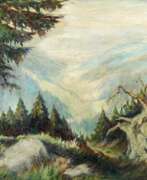

Friedrich August Baer was a German painter who initially pursued law but turned to painting after being inspired by Eduard Schleich's work. He was a self-taught artist who received guidance from Adolf Lier and Hermann Baisch. Baer was a member of the Munich Art Association and exhibited his works in various exhibitions across Germany and Austria. He became interested in painting high mountain landscapes and was occasionally misunderstood for his unique style. Baer was also a writer and book illustrator and received several medals and awards for his artistic achievements.




Constantin Ludwig Bauer was a German painter. Numerous landscape watercolors come from Bauer. Bauer studied from 1869 to 1873 at the Academy of Fine Arts in Munich. He learned figure painting from Alexander Wagner and copperplate engraving from Johann Leonhard Raab. In 1878 Bauer moved to Obermais (South Tyrol). There he devoted himself to landscape painting.


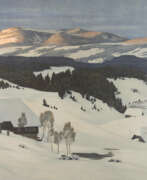

Karl Biese was a German landscape painter, draftsman, and lithographer. After initially working as a theater painter, he received a scholarship to study at the Karlsruhe Academy of Fine Arts in 1883. Biese later returned to Hamburg, where he became a master painter and established his own business. Biese was one of the founders of the Karlsruhe Artists' Association and created lithographs for the association's print workshop. He found inspiration for his nature-themed works during his travels around Karlsruhe, the Black Forest, the Moselle region, and northern Germany. Biese was particularly known for his atmospheric paintings, especially his winter scenes. He primarily worked with oil painting and lithography mediums. Biese also designed collectible images for Stollwerck chocolate company's albums.


Ernest Leonard Blumenschein is an American painter, member of the Taos Society of Artists. He is known for his paintings of the American Southwest. He studied at the Cincinnati Academy of Art and the Julian Academy.
Ernest Leonard Blumenschein often depicted Native Americans and landscapes of the Southwest in his paintings. He was known for his masterful use of colour and light, and his works had a strong sense of realism. Blumenschein also worked as an illustrator and writer, and his book Navajo War Dance is considered a classic of Native American literature.
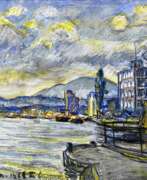

Erwin Bovin is a German painter and poet. He received his first art education at the School of Applied Arts in Neuchâtel under the direction of William Racine. He took part in the First World War as an interpreter. During this time, he created, among other things, drawings and watercolors depicting the front in the Argonne forest. After the war, he continued to study and worked as an art teacher. In 1932-1942 he lived as a freelance artist. After leaving his position as a teacher, he went to Amsterdam to visit the Rembrandt exhibition there, and then stayed to live in the Netherlands. In addition to landscapes, Bovin painted numerous portraits and family paintings for wealthy Dutch people.
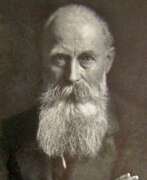

Eugen Felix Prosper Bracht was a German landscape painter.
A late Romanticist painter, Bracht was known for his moody landscapes and coastal scenes in North Germany, and began a sketching trip through Syria, Palestine and Egypt from 1880 to 1881. In 1882, he became a Professor of Landscape Painting at the Prussian Academy of Arts.
Later, Bracht became a representative of German Impressionism.
In 1901, he obtained a teaching position at the Dresden Academy of Fine Arts that he held until 1919.


Herbert Brandl is one of the most famous Austrian expressionist artists. He achieved success through his large-format works.
Landscape as a theme was always dominant in his work, where pictorial abstraction and subjectivity alternate. Since the beginning of the new millennium, Brandl's passion for the monumentality of mountain landscapes has become increasingly evident. Using various formats and techniques, the artist has reinterpreted the theme of mountains, playing with expressive gestures, abstract colour spaces and massive forms.
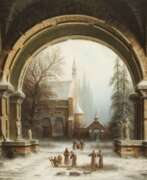



Louis Buvelot, born Abram-Louis Buvelot, was a Swiss landscape painter who lived 17 years in Brazil and following 5 years back in Switzerland stayed 23 years in Australia, where he influenced the Heidelberg School of painters. Buvelot is best known for his great contribution to Australian art. His works, mostly oil landscapes, are quite well regarded, but perhaps his impact was even greater as a tutor of several members of the Heidelberg School. His enthusiasm for plein air painting (that is, painting directly in the open air) was a key characteristic of those artists' work.


Carl Gustav Carus was a German painter of the first half of the 19th century. He is known as a landscape painter, as well as a scientist, physician (gynecologist, anatomist, pathologist, psychologist) and a major theorist of Romanticism in art.
Carus created idyllic landscapes depicting moonlit nights, mountains, forests, Gothic architecture and ruins. In his work, according to critics, he combined a romantic view of nature with the classical ideal of beauty, understood the beautiful as a triad of God, nature and man. Noteworthy are his small-format, spontaneously created landscape sketches with images of clouds. The master is the author of "Nine Letters on Landscape Painting" - one of the main theoretical works that laid the foundations of the German Romantic school of painting.
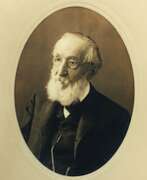

Benjamin Champney was a painter known for his role in White Mountain art of the 19th century. He began his training as a lithographer under celebrated marine artist Fitz Henry Lane at Pendleton's Lithography shop in Boston. Most art historians consider him the founder of the "North Conway Colony" of painters who came to North Conway, New Hampshire and the surrounding area during the second half of the 19th century. His paintings were often used to make chromolithographs that were subsequently sold to tourists who could not afford Champney's originals. He exhibited regularly at the Boston Athenæum and was a founder of the Boston Art Club.
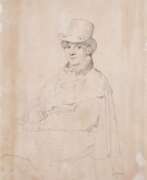

Pierre-Athanase Chauvin was a French painter active in Italy.
Chauvin was a student of the landscape painter Pierre-Henri de Valenciennes. He began his career at the Paris Salon in 1793 and won the First Class Medal in 1819 with his painting Charles VIII’s entry into Acquapendente. The painting was commissioned by Louis XVIII of France for the Galerie de Diane at the Palace of Fontainebleau.


Edward Harrison Compton was a German landscape painter and illustrator of English descent.
Like his father he was inspired by the Alps to become a mountain painter (Bergmaler) working in both oils and watercolour. However, an attack of Polio at the age of 28 meant that he had to find more accessible landscapes to paint in Germany, England, northern Italy and Sicily. He also provided illustrations for several travel books published by A & C Black.
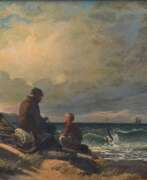

Johann Wilhelm Cordes was a German landscape painter.
Johann Wilhelm Cordes entered the Academy of Fine Arts in Prague, then moved to the Academy of Fine Arts in Düsseldorf in 1842, where he studied with Karl Friedrich Lessing and Johann Wilhelm Schirmer.
He specialised in realistic landscapes painted during his travels. He also created coastal scenes with staffage.
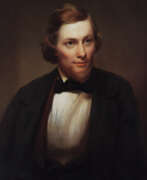

Jasper Francis Cropsey was an important American landscape artist of the Hudson River School.
Cropsey's interest in architecture continued throughout his life and was a strong influence in his painting, most evident in his precise arrangement and outline of forms. But Cropsey was best known for his lavish use of color and, as a first-generation member from the Hudson River School, painted autumn landscapes that startled viewers with their boldness and brilliance. As an artist, he believed landscapes were the highest art form and that nature was a direct manifestation of God. He also felt a patriotic affiliation with nature and saw his paintings as depicting the rugged and unspoiled qualities of America.
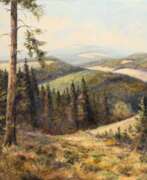

Paul Wilhelm Dams was a German animal painter who specialized in hunting motifs. He painted game - wild boars, foxes, deer, roe deer, hares - in a winter or autumn forest landscape, he especially loved birds - capercaillie, black grouse and pheasants. The artist lived in Ridsend in Bavaria, and during the Second World War also in Braunschweig, where he painted numerous motifs of the Harz mountains.
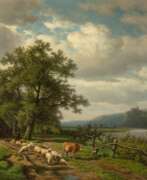

Alexander Joseph Daiwaille was a Dutch portrait painter. He specialized in painting portraits, like his father, although he later in life painted landscapes. He traveled and worked all around the Netherlands and Germany. Daiwaille then moved and settled in Brussels where he lived until his death in 1888.
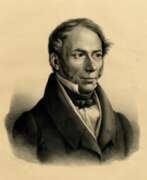

Jean Baptiste de Jonghe was a Belgian painter, draughtsman, etcher and lithographer. He is known for his Romantic landscapes with people, herds and ruins. In his graphic work he also made views of cities in the area of what is now Belgium and the Netherlands. He was an art professor at the Academy of Kortrijk and the Antwerp Academy of Fine Arts.
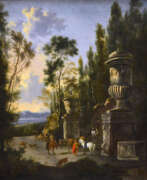

Frederik de Moucheron the Elder was a Dutch landscape painter of the Dutch Golden Age.
Frederik studied under Jan Asselain (1610-1652), then spent three years in Paris before settling in Amsterdam in 1659. De Moucheron painted French, Italian and Dutch landscapes, reproducing with particular care the effects of sunset and gray clouds. Works by this artist are represented in many European art galleries, such as those in St. Petersburg and the Dresden Gallery.
He was the father of the landscape painters Isak de Moucheron and Frederik de Moucheron the Younger.
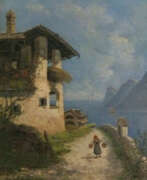

Gabriele Maria Deininger-Arnhard was a German-Austrian painter.
Deininger-Arnhard painted mostly landscapes from the Tyrolean and Bavarian regions, but also depicted rural interiors, in oil and watercolor. She was best known for her depictions of the Ötztal. According to her own account, she painted more than 1,000 large-format oil paintings. These may be found in collections in various cities in Germany, Tyrol, Vienna, Paris, Holland, Switzerland, the Czech Republic, Hungary and North America.
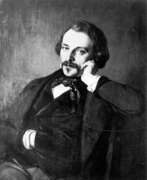

Jakob Fürchtegott Dielmann was a German illustrator, genre and landscape painter. He focused on genre art, but also painted plein air style at the Mittelrhein, the Main and throughout Hesse. In 1841, Gerhardt von Reutern invited him to visit the Artists' Colony in Willingshausen, where he created scenes of village life. The following year, he opened a studio at the Städelschule and took further lessons with Anton Burger. In the early 1860s, he and Burger moved to Kronberg, where they founded their own artists' colony. In addition to painting, he often worked as an illustrator.
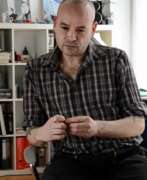

Georg Dinz is a contemporary Austrian artist. After studying at the Vienna University of Applied Arts, Dienz lives and works as a room and stage designer in the Viennese punk scene. Shortly after the fall of the Wall, Dienz moves to Berlin, where he takes part in various art projects in the wild post-reunification period. Today he concentrates on free painting in his studio in the former Berlin artist district of Prenzlauer Berg. Georg Dienz's works are stylistically characterized by a flat and clear application of paint and can be described as "reduced realism".
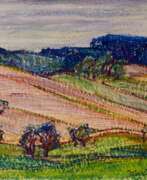

Max Doerner was a German artist and art theorist. Doerner's artistic education was at the Academy of Fine Arts Munich where he studied under Johann Caspar Herterich and Wilhelm von Diez. His style was impressionistic. He travelled around Europe, in particular to the Low Countries and Italy, and studied the old techniques of painting. He is most noted for his work The Materials of the Artist and Their Use in Painting, first published in 1921. His approach inspired the founding of the Doerner Institute. He was also an instructor at the Munich Academy, where his students included Karl Gatermann the Younger.
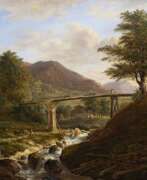

Johann Jakob Dorner the Younger was a Bavarian landscape painter. The son of Johann Jakob Dorner the Elder, he was born in Munich and was instructed in art by his father and by Mannlich. He travelled by himself through the picturesque regions of Bavaria, Switzerland, and France. His works are distinguished for spirited composition and taste in their execution. In 1803 he became Restorer, and in 1808 Inspector of the Royal Gallery at Munich, and was subsequently elected a member of the Academies of Hanau, Vienna, Berlin, and Munich.


Pierre Louis Dubourcq was a Dutch landscape painter, lithographer and etcher. He was a student of Jan van Ravenswaay in Hilversum in 1834 and of Andreas Schelfhout in The Hague in 1835. He mainly painted mountain and forest landscapes and he etched, drew, created watercolors and lithographs. From 1834 to 1858 he took part in the exhibitions in Amsterdam and The Hague. Prince Alexander of Orange-Nassau commissioned him to do some watercolors of the falconry hunts at Het Loo Castle. He was a member of Arti et Amicitiae, the Koninklijke Academie van Beeldende Kunsten and the Natura Artis Magistra Society.


Gaspard Duguet, also known as Gaspard Poussin, was a French painter specialising in landscape painting. He was born into a family of French painters who settled in Rome.
Gaspard Duguet received his artistic training from his uncle, Nicolas Poussin, who was one of the leading Baroque painters. Duguet's early works were strongly influenced by Poussin's style, which emphasized clarity and orderliness of composition.
In the 1650s, Duguet began to develop a style of his own, characterized by his bold brushwork and vibrant use of colour. He became known for his ability to create dramatic and atmospheric landscapes, often depicting scenes from the Roman countryside.
Gaspar Duguet's paintings have a sense of grandeur and monumentality. His landscapes often feature classical ruins and ancient monuments, giving his works a sense of historical depth and resonance.
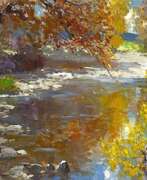

Fremont F. Ellis was an American impressionist painter who expressed a deeply intuitive perception of nature in his works.
He painted in a style strongly influenced by the Impressionists, using bold strokes and vivid colours to convey light and atmosphere in his landscapes. Being self-taught, he joined a well-known group of young Santa Fe artists, Los Cincos Pintores. For nearly 70 years Ellis drew inspiration from the beauty of New Mexico's landscapes.
Ellis' work continues to influence contemporary artists. His work has been exhibited in many galleries in New York, London and Paris. Ellis received many prestigious awards during his career, including the Julian Medal and the Gold Medal at the Paris Salon in 1930. His work is held in several museums, including the Harwood Art Museum in Taos, New Mexico, and the National Museum of American Art in Washington, D.C.
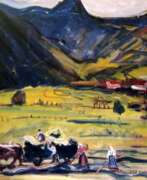

Alphonse Epple was a German landscape, portrait and ecclesiastical painter. In 1919 he studied at the Stuttgart School of Applied Arts under Bernhard Pancock. Presumably, he learned there the technique of fresco painting, the skill in which brought him commissions in later years. His passion was the depiction of religious subjects. In addition to paintings on religious motifs, he painted portraits of friends and acquaintances, landscapes depicting the idyll of his native nature or reflecting an interest in the rural and folk way of life. Apple uses a free, fast brush to capture the ever-changing lighting situation. His oil paintings are characterized by impasto application of paint, and the influence of the Impressionists is especially noticeable in the depictions of landscapes. Completely abandoning contours, Epple formed his compositions from wide dotted lines located side by side.
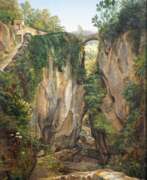

Johann Joachim Faber was a German landscape painter and printmaker. He initially worked on historical subjects. During his travels to Italy he became interested in landscape painting, in which he became known.


Jakob Fischer-Rhein, a German artist, was a talented draftsman, portrait and landscape painter.
After training as a technical draftsman, he studied at the Düsseldorf Art Academy and continued his studies in Munich. During the First World War he was a prisoner of war in France, where he was able to continue painting.
Fischer-Rhein also established himself in America and created impressive works, particularly of the New York skyline.
He was a member of the SA during the Nazi era and was represented at National Socialist exhibitions. After the war he settled in Miltenberg and painted motifs from various cities. Fischer-Rhein considered himself an academic painter and stayed away from modern trends.


Henry Garland was a British painter. He was primarily known for his landscape paintings, which often depicted rural scenes of England, Scotland and Wales.
Garland's work is characterised by a romanticised view of the countryside with rolling hills, livestock and tranquil streams. The painter was particularly adept at capturing the atmospheric effects of light and weather in his paintings, and his use of colour was subtle and evocative.
Today Henry Garland is regarded as one of the leading British landscape painters of his generation, and his work is still highly regarded for its sensitivity to the natural world and its depiction of a rapidly changing society.


Hermann Ernst Friedrich Garling was a German painter who specialised in landscape painting.
Hermann Garling's work includes rural views of the Karlsruhe countryside, city scenes and mountain landscapes.
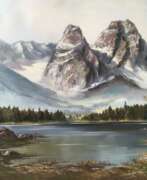

Karl Gatermann the Elder was a German painter and graphic artist. He was the uncle of artist Karl Gatermann, who is typically called "Karl Gatermann the Younger" to distinguish between the two. In 1910 he received the First Prize for Painting of the City of Munich for the oil painting Life. From 1919 to 1942 he lived and worked in Lübeck. In Berlin in 1923 and 1925, he exhibited his watercolors in the galleries of Rudolf Wiltschek and in the Kunsthaus Heumann in Hamburg in 1926. Gatermann's watercolors were also shown in England and in the London Times. Gatermann predominantly focused on north German landscapes and cities, though he also painted still life and figurative scenes, and portraits of people.
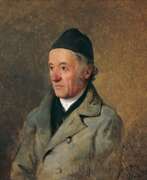

Jakob Gauermann was a German artist of the late eighteenth and first half of the nineteenth centuries. He is known as a painter and graphic artist who originally worked as a stone carver.
Jakob Gauermann became famous for his works depicting the nature of mountainous regions. He created numerous landscapes of Swiss landscapes and mountainous regions of Austria. His creative legacy includes a limited number of oil paintings and a significant number of watercolors.
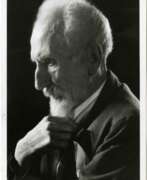

Albert Gos was a Swiss painter-painter, musician, and writer. A great admirer of high mountains, he called himself a "mountain painter. He mainly painted mountain views and landscapes. His favorite view is the Matterhorn in the Pennine Alps.


Marco Gozzi was an Italian landscape art painter.
Gozzi worked initially in a broad range of fields including portraiture, religious subjects and decorative frescoes executed in accordance with the Veneto tradition, then still predominant in the region of Bergamo.
While he never held the chair in landscape at the Academy of Brera, he was elected an honorary member in 1829 and qualified as a landscape painter in 1832.
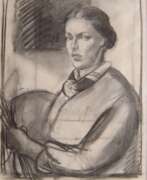

Norah Gurdon was an Australian artist. Gurdon attended the National Gallery School from 1901 to 1908, being taught by noted artists Frederick McCubbin and Bernard Hall. An accomplished landscape and still-life painter, Gurdon exhibited her works with the Victorian Artists Society while still a student. She established her artistic prowess early on by winning the major category for oil painting in the 1909 City of Prahran's Art Exhibition Prize.
Norah Gurdon was a regular and successful exhibitor of work, exhibiting with the Victorian Artists Society, Melbourne Society of Women Painters and Sculptors, and the Australian Art Association. In the 1920s she held many solo exhibitions at the Athenaeum Gallery, and later at the Women's Industrial Arts Society in Sydney, and the Royal Queensland Art Society in Brisbane.
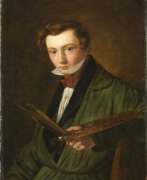

Heinrich Louis Theodor Gurlitt was a German and Danish painter of the second half of the 19th century. He is known as a Romantic landscape painter, a representative of the Hamburg and Düsseldorf schools.
Louis Gurlitt created canvases that are now part of the Royal Danish collection of paintings. Among his famous works are "Landscape near Salzburg", "Monte Pellegrino", "Ieranto Bay with Fishermen" and "Northern Italian Landscape". His works have been exhibited at the auctions "19th Century Painting" and "19th Century European Painting", and the painting "Norwegian Landscape" was sold in 2012 at Sotheby's London for $22,174.


Anton Gutknecht was a German-American landscape painter known for his maritime seascapes of southern California and rural Europe. With a particular interest in the tumultuous nature of the ocean, the artist often focused on capturing waves crashing on the shore or on the boughs of a ship rendered in a high level of realistic detail. Gutknecht spent his early life traveling between different areas of the country, notably Munich and Hamburg, observing the mountainous terrain that would later be the focus of his work and bring him recognition. Gutknecht taught at the Royal Academy in Vienna before frequently traveling to southern California in the 1930s, eventually moving there to settle in Palm Springs and focus on capturing the landscape there.
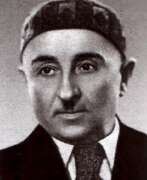

Gabriel Mikaelovich Gyurdzhyan (Armenian Գաբրիել Գյուրջյան) was an Armenian painter. People's Artist of the Armenian SSR (1945), art historian, teacher. One of the founders of the Soviet Armenian fine arts.
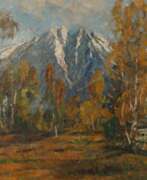

Karl Georg Hänel was a German landscape and animal painter and commercial artist.
Hänel undertook study trips to Mecklenburg, Bavaria, Switzerland and the Salzburg Alps. He mainly worked as a landscape and animal painter. As a commercial artist he created advertising posters, calendar pages and advertisements.


Zacharias Heinesen is a Faroese painter. He is the son of the writer and artist William Heinesen.
His works include oil paintings, watercolour paintings, drawings, woodcuts, lithographs and paper collages.
His paintings were featured on a series of stamps in June 2001.
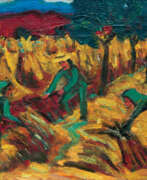

Walter Helbig is a German and Swiss painter, graphic designer and woodcarver. He works in Dresden on church paintings. Helbig participated in the founding and first exhibition of the "Neue Secession" in Berlin in 1910. Helbig took part in the first Modern Bund exhibition in 1911 in Lucerne and in the second, larger one, at the Kunsthaus in Zurich. In 1914, some painters from the vanished “Modern Bund”, including Helbig, took part in the first Dada exhibition at the Galerie Coray in Zurich. Helbig is also represented in the third Dada exhibition and contributes to the magazine Der Zeltweg 8 but does not participate in the activities of the Dadaists. In 1919, he was one of the signatories of the “manifesto of radical artists” 9 in Zurich, and joined the “November group” in Berlin. Helbig lived in Zurich from 1916 to 1924 and in 1916 became a member of the GSMBA (Society of Swiss Painters, Sculptors and Architects), in which he regularly participated. Since the First World War, his artistic work has turned to religious and mythical subjects. In 1924 Helbig, like many other artists, moved to Ascona due to the low cost of living and founded the movement Der Große Bär. During this time, Helbig painted landscapes, still lifes and portraits. Walter Helbig had his first major solo exhibition in Zurich in 1948 and became a member of the Association of German Artists in 1952. After the Second World War, he also followed the artistic currents of the time, abstract expressionism and experimented with informal art in the 1960s.
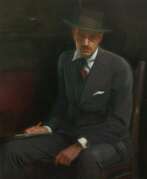

Ernest Martin Hennings (Jr.) was an American artist and member of the Taos Society of Artists. In 1901 that Hennings began taking classes at the School of the Art Institute of Chicago, which was largely based on the great European art schools and made particularly emphasis on the importance of drawing. Hennings took up work as a commercial artist, mostly painting murals and portraits around Chicago. Hennings' primary interest was in portrait painting, with his primary subject being the Native Americans living in and around Taos Pueblo. In 1922 he was awarded the Clyde M. Carr Prize from the Art Institute of Chicago as well as the Institute's Fine Arts Building Prize. By the 1920s, the now established painter was building his reputation on the national scene, with exhibitions and awards including. Many art collectors throughout America sought out his paintings. Today paintings by Hennings are housed in the Smithsonian American Art Museum, Stark Museum of Art, Booth Western Art Museum etc.


Hanns Herzing was a German painter. He is best known for his high mountain views. He left mainly mountain and high mountain paintings, which he exhibited in several studio exhibitions on the subject of mountain landscapes. One of his best-known paintings was the Matterhorn reflected in the Riffelsee, which was distributed as a reprint on postcards.

Aldro Thompson Hibbard was an American artist known for his depictions of rural New England landscapes.
Hibbard studied at the School of the Museum of Fine Arts in Boston and later at the Académie Julian in Paris. He became a prominent member of the Rockport Art Colony in Massachusetts, where he spent most of his career teaching and painting.
Hibbard's paintings were primarily landscapes, often featuring snow-covered hills, barns, and farmhouses. He painted in a realist style, with an emphasis on the effects of light and atmosphere on the New England countryside. Hibbard was also an accomplished etcher, and his prints often depicted similar subjects to his paintings.
Today, Hibbard's work can be found in the collections of museums such as the Smithsonian American Art Museum in Washington, D.C., and the Museum of Fine Arts in Boston. He is considered an important figure in the development of American landscape painting, and his depictions of rural New England continue to be celebrated for their beauty and realism.
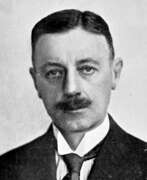

William Victor Higgins is an American artist. He is known for his landscape paintings and is considered one of the most important representatives of the Taos Society of Artists. He studied painting at the Chicago Academy of Fine Arts and at the Académie Julian in Paris with Robert Henri, René Menard and Lucien Simon.
William Victor Higgins often depicted the rugged landscapes and Indians of the American Southwest in his paintings. He was particularly interested in Native American culture and often painted portraits of them. His work is characterized by bold strokes and vivid colours.


